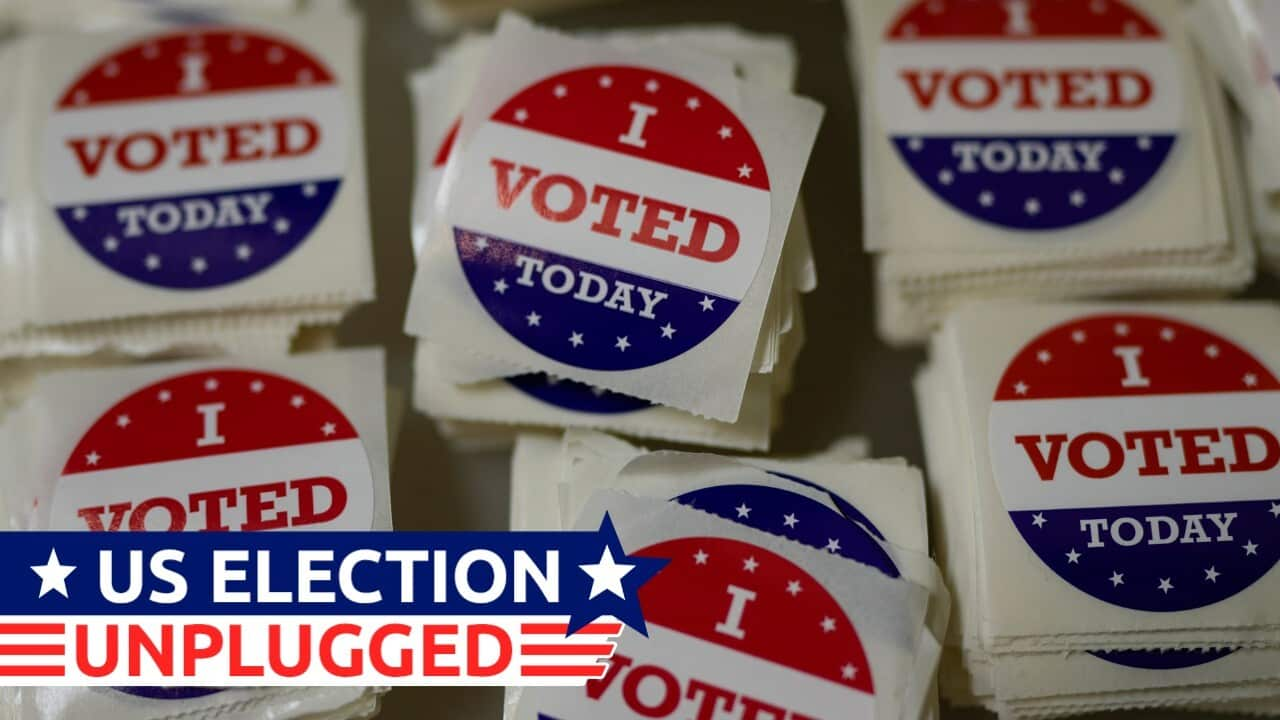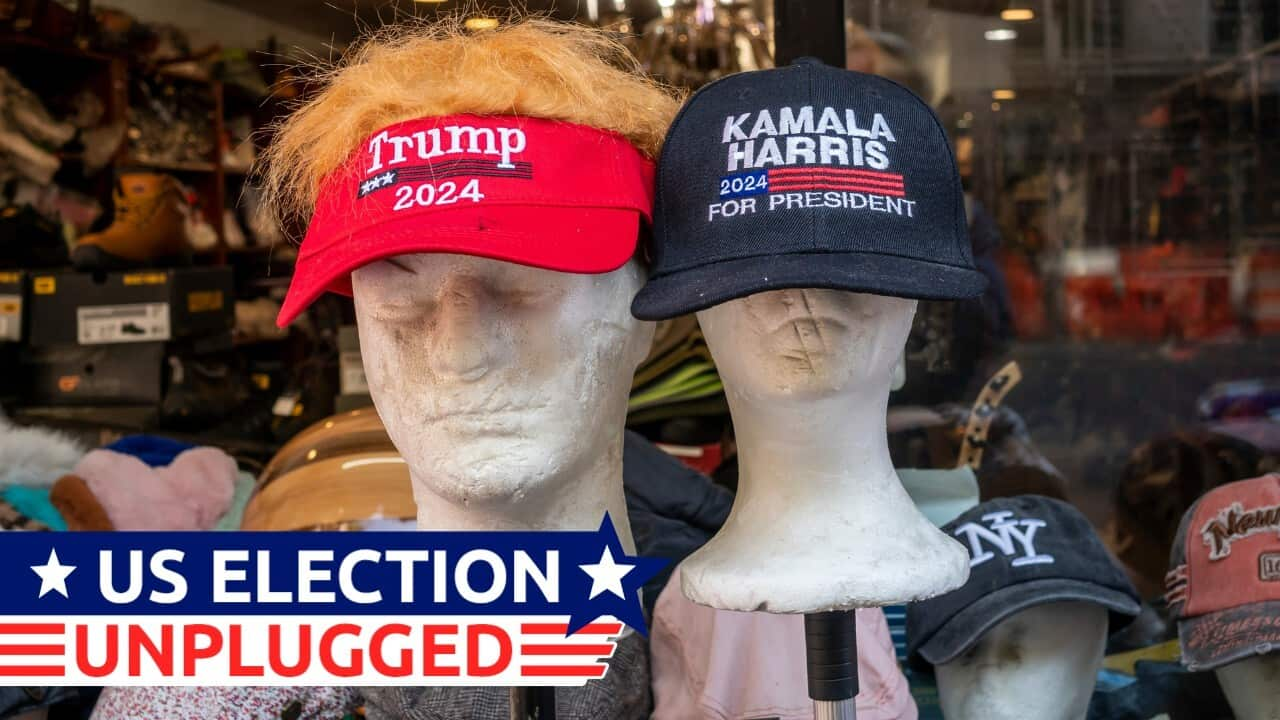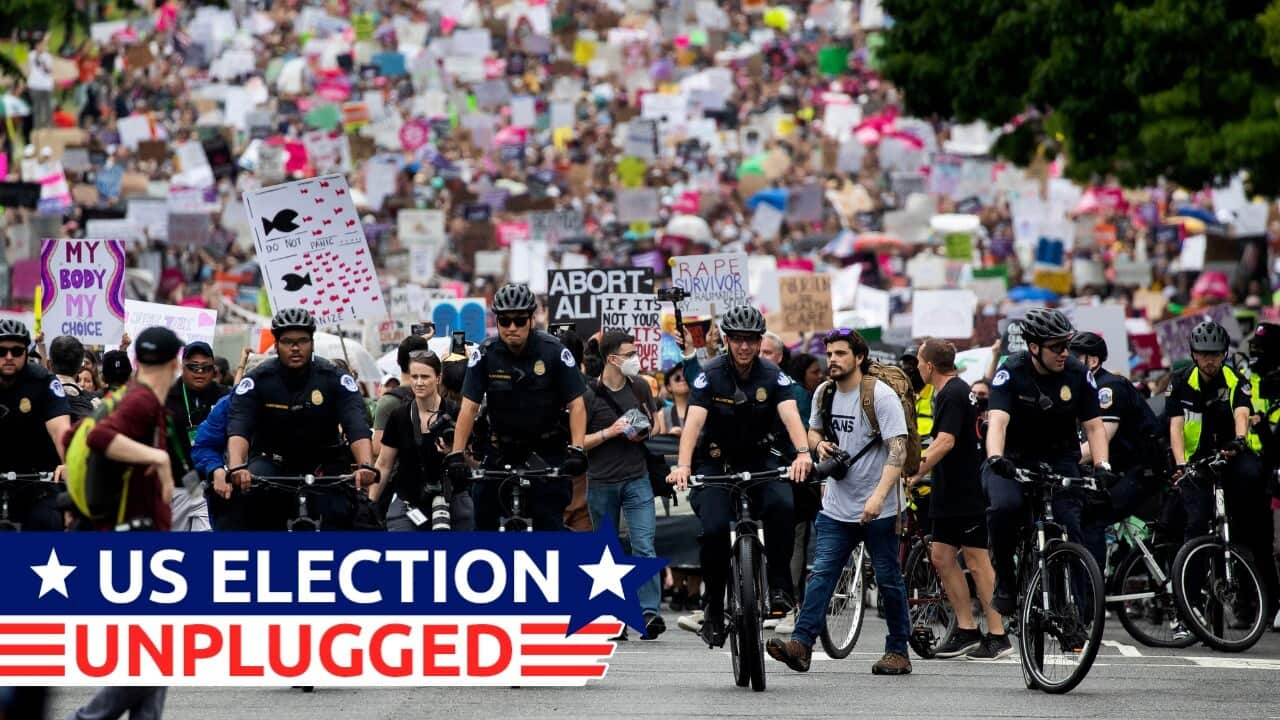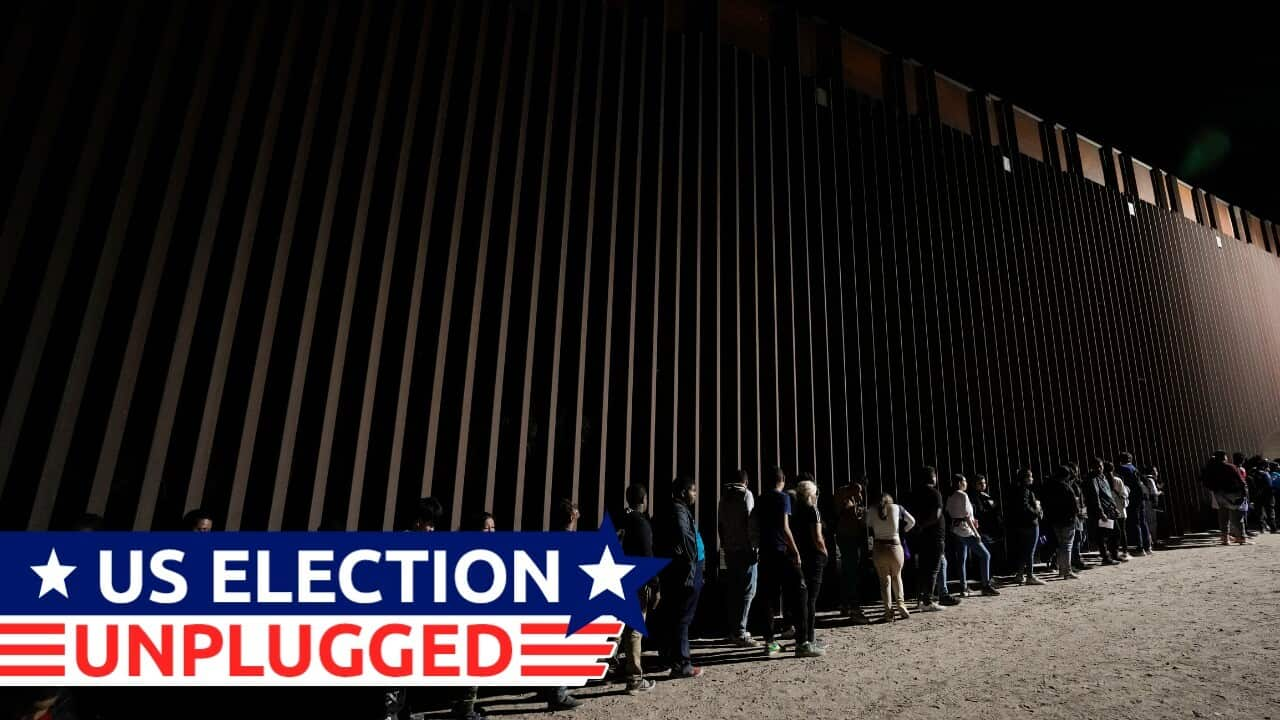TRANSCRIPT
In this episode we're going to give you everything you need to know to understand this election day in the United States.
After months and months of campaigning and controversy, with some candidates dropping out...
“So I've decided the best way forward is to pass the torch to a new generation.”
...and others coming close to dropping dead...
“Last week I took a bullet for democracy.”
... at last, the U-S presidential election is finally upon us.
Americans are heading to the polls on the 5th but here in Australia we'll start to see those votes pour in on the morning of Wednesday the 6th.
Another important thing to remember is that, while much of the focus is understandably on the battle between Donald Trump and Kamala Harris, Americans will also be electing about a third of the US Senate at the ballot box as well with all 435 seats in the House of Representatives up for grabs too.
With the presidential race neck-and-neck, we're going to go through some of the likely pathways to winning the presidency for both candidates but, first, let's take a look at some of the major differences between the US and the Australian voting systems.
“We've gotta figure out what's going on.”
So, right off the bat, what you need to know is that voting in the United States is completely optional.
In fact, the 2020 election saw just 66 per cent of eligible voters cast a ballot and that was the highest rate for any national election since the year 1900.
While this may sound appealing for those who don't want to spend their morning lined up at their local school or town hall, Bruce Wolpe from the United States Studies Centre says it also means more extreme political candidates get a better shot at the top job.
“The whole issue out of this election is the turnout, and if your side turns out more, you win. In Australia, everyone votes. But, together with preferential voting, it means that the country always lands centre-left or centre-right. So a blow in like Trump cannot come to Australia and become Prime Minister and Clive Palmer will never be Prime Minister, Pauline Hanson will never be Prime Minister.”
The second key thing you need to know about the U-S election is that it doesn't necessarily matter which presidential candidate wins the majority of the votes.
That may sound odd and it kind of is.
Other presidential republics like Brazil, Argentina and South Korea all directly elect their presidents.
But Mr Wolpe says the founding fathers of the United States had a different idea.
“The founders did not believe in direct election of the president so they wanted a little buffer. So each state has what's called Electoral College votes.”
So, if you're aware of the Electoral College system you may be rolling your eyes here...
“Oh no.”
...because it's very controversial.
But, in a nutshell, there are 538 Electoral College votes in America that are divided out across each state, and whichever presidential candidate wins a majority of these votes - that being 270 - will become the 47th president of the United States.
The number of these votes in each state matches the number of senators plus the number of members of the house.
So, for instance, California has 54 votes in the Electoral College because they have two senators and 52 members of the house.
But even this is controversial as, while the number of house representatives is based off each state's population, the founding fathers deemed that the number of senators in each state is always going to be two.
“That's another undemocratic thing. Wyoming has two senators. Well, so does California and California has about 50 times the number of people as Wyoming but those two senators are the same power.”
Ok, so after each state casts their ballots on November 5, the votes will be tallied, with the outcome passed on to a slate of electors who will then attend a meeting of the Electoral College on December 17 where they will cast their 538 votes to formally elect the new President and Vice President.
In almost all US states, it's a "winner takes all" system where the candidates who get the most votes from the public win the support of all the electors of that state.
This generally means that the candidates with the most amount of votes nationally wins the presidential race but due to a couple of high profile exceptions to this rule in recent years the system has come under a whole lot of scrutiny.
“There are a lot of Americans who have become more acutely aware of their system. I mean two of the past five elections have been where the winner does not win the popular vote.”
“We can now predict the winner of the presidential race. CNN projects Donald Trump wins the presidency, capping his improbable political journey with an astounding upset victory. Donald J Trump will become the 45th president of the United States, defeating Hillary Clinton in a campaign unlike anything we've seen in our lifetime.”
Yes, in 2016 the design of the Electoral College system meant that Donald Trump won a dominant 306 electoral votes to Hillary Clinton's 227 despite almost three million more voters supporting Clinton.
And with the polls between Donald Trump and Kamala Harris incredibly tight we may yet see this discrepancy between the popular vote and the Electoral College vote once again.
Trump's first election, along with George Bush's controversial win in the year 2000, has led many to believe that the indirect system of election is not only confusing but unfair and undemocratic.
“We don't know what's happening and it's gotta stop, and it's gotta stop fast.”
63 per cent of Americans told a Pew Research Center survey that they'd prefer the winner of the presidential election to be the candidates who win the most votes nationally.
But Republican Vice Presidential candidate JD Vance has been a defender of the status quo.
“The way that our founders set up the United States constitution is that Electoral College determines the victor in the American presidential election. That's the way that it is and that's the way that it's going to be as far as I'm concerned.”
Now, some may argue that a big reason Republicans are more sympathetic to the Electoral College is that they have not won the support of the majority of US voters since 2004, as pointed out by Republican Nikki Haley.
“We've lost the popular vote in the last seven out of eight presidential elections. Our cause is right but we have failed to win the confidence of a majority of Americans.”
Tim Walz, the Democratic Vice Presidential candidate, has called for the Electoral College to be abolished.
He told an ABC News interview that it's not the official position of the Harris campaign but he thinks its important to consider the concerns of voters.
“Well it's not the campaign's position and the point I'm trying to make is, is that there's folks that feel every vote must count in every state and I think some folks feel that's not the case. Their position and my position is to make sure that everybody understands that their vote, no matter what state they're in, matters.”
So if not all votes are equal, which voters and which states matter most in the presidential race?
While the latest polling averages has the race split almost exactly 50 / 50, the path to victory for Donald Trump or Kamala Harris lies in what are known as the battleground states or swing states.
These swing states are not a permanent fixture as voting habits and demographics change over time but Bruce Wolpe from the U-S Studies Centre says there are currently seven crucial states that fluctuate between Democrats and Republicans.
“So the swing states are those that are going back and forth over the past two, three elections. So this year it's Pennsylvania, Michigan, and Wisconsin. Those are states that Trump won in 2016 and won the election. Biden won them in 2020 and won the election. Where are they going to go this year? And then Arizona, Nevada, Georgia, and North Carolina. And they also will contribute one way or the other to it.”
The seven states can be divided into what is known as the Rust Belt in the north which includes Michigan, Wisconsin and Pennsylvania and the so-called Sun Belt in the south which is Arizona, Nevada, Georgia and North Carolina.
And the swing state with the most votes in the Electoral College, which lies at the heart of both candidate's most likely path to success, is...
TRUMP SUPPORTER: "Pennsylvania."
WALZ: "Pennsylvania."
HARRIS: "Hello Pennsylvania."
TRUMP: "Hello Pennsylvania.”
A recent presidential forecast model from The Economist shows - out of 10,001 simulations they ran of the election - Kamala Harris and Donald Trump have an 89 per cent chance of winning the election if they can capture Pennsylvania.
According to recent polling, Kamala Harris' most likely pathway to victory would be winning the Rust Belt, namely Pennsylvania, Michigan and Wisconsin.
With Pennsylvania's 19 votes that would put her up to the exact electoral count needed to win the election - 270 votes.
A less likely scenario would see Harris repeat Joe Biden's 2020 victory where he won all but one of the swing states receiving 306 votes.
“Nobody can do that!”
And Trump's most-likely path to victory?
Well, one way is that - if he can secure that vital Pennsylvania battleground - he'd also be able to scrape in on 270 votes with the addition of North Carolina and Georgia.
There's also a chance the close odds could split well for Donald Trump and we could have a repeat of his commanding 2016 win when he took Pennsylvania, Michigan and Wisconsin as well as Georgia, Arizona and North Carolina - giving him 307 electoral votes.
“We're gonna win so much you may even get tired of winning. You'll say 'Please, please, it's too much winning. We can't take it anymore!'“
The other question you might be asking is when will we really know the outcome?
Well, chances are you won't know for a few days as a number of states aren't allowed to begin counting early votes until election day, delaying results.
And, just in case you forgot, the 2020 election was on November 3rd and it took four whole, anxiety-inducing days, on November 7th, for Joe Biden to declare victory.
Donald Trump of course never conceded, falsely accusing the Democrats of stealing the election and allegedly attempting to change the results in his favour.
“It took a few days. Pennsylvania does take its time counting, and Arizona took its time counting. I expect we'll see more of the same. I know this. Trump is going to claim victory on the night, probably early, say 'You know I won'. And then of course, everything is stolen after that. I think the narrower the margin, the higher the anxiety. And so we will see on election night just how narrow the margin is.”
So, we're not quite out of the woods yet.
I'm Sam Dover and you've been listening to 'US Election Unplugged' - a podcast series by SBS News.
If you want to learn more about the key issues concerning American voters have a look at our previous episodes on immigration, abortion and foreign policy.
You can find these episodes and more on the SBS News app, Spotify, or Apple podcasts and stay tuned to SBS News In Depth as we take you through the results and the fall-out from this historic election.













